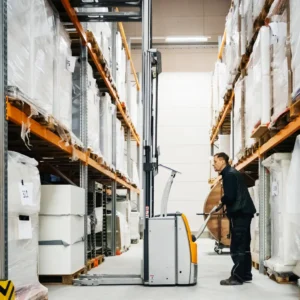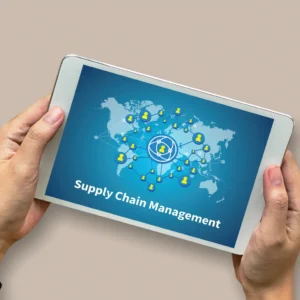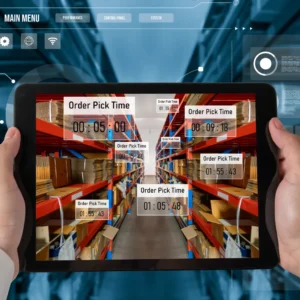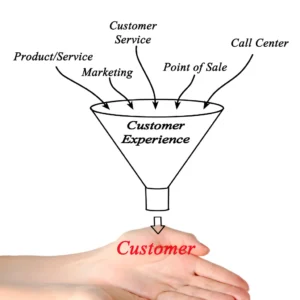
Revolutionizing Logistics
AI Tools for Sustainability and Green Practices in the Logistic Industry for Eco-Friendly Supply Chains.
AI Tools for Sustainability and Green Logistics in the Logistic Industry are pivotal in revolutionizing how businesses approach environmental impact and operational efficiency.
In the fast-evolving landscape of the logistics industry, the integration of cutting-edge technologies is shaping a more sustainable and eco-friendly future. Leveraging AI, these tools address route planning, carbon tracking, packaging, energy analysis, and sourcing.
Logistics organizations use AI to optimize resource use, reduce emissions, and make informed decisions for sustainable practices. This discussion delves into the intricacies of developing and implementing these transformative tools, exploring their business implications, technological requirements, and the broader impact on the transportation and logistics ecosystem.
Table of Contents

Arindam Roy
An Automation Consultant with 25+ years of IT Experience
5 AI Tool ideas for Sustainability and Green Practices
Creating AI tools for sustainability and green logistics in the transportation industry can significantly reduce environmental impact. Here’s an elaboration on the tools you’ve mentioned:
Eco-Friendly Route Planning:
- Utilize machine learning algorithms to analyze historical traffic data, weather conditions, and road infrastructure to optimize routes for fuel efficiency.
- Incorporate real-time data to adjust routes based on traffic, accidents, or other unforeseen events.
Carbon Footprint Tracking:
- Develop a system that tracks and calculates the carbon footprint of each shipment by considering the mode of transportation, distance travelled, and the fuel used.
- Implement machine learning models to predict and optimize carbon emissions, providing insights into how different decisions impact overall sustainability.
Green Packaging Recommendations:
- Use AI algorithms to assess and recommend sustainable packaging materials based on weight, fragility, and destination.
- Implement image recognition to identify and categorize packaging materials, offering suggestions for eco-friendly alternatives.
Alternative Energy Adoption Analysis:
- Employ AI to analyze the feasibility and benefits of adopting alternative energy sources for transportation fleets, such as electric vehicles, hydrogen fuel cells, or biofuels.
- Consider cost, energy efficiency, and available infrastructure for charging or refuelling.
Sustainable Sourcing Guidance:
- Implement machine learning models to evaluate suppliers based on their sustainability practices, helping companies make informed decisions about sourcing materials.
- Provide recommendations on alternative suppliers or materials that align with environmentally friendly practices.
These AI tools can be integrated into existing logistics and transportation management systems to provide real-time, data-driven insights and recommendations. They can help the industry reduce its carbon footprint and adopt sustainable practices. The combination of route optimization, carbon tracking, green packaging suggestions, alternative energy analysis, and sustainable sourcing guidance can significantly impact the environmental sustainability of the transportation and logistics sector.
Eco-Friendly Route Planning
Business Knowledge Requirements:
- Transportation and Logistics Expertise:
- In-depth understanding of the transportation and logistics industry, including knowledge of different transportation modes, regulatory requirements, and the intricacies of route planning.
- Familiarity with the environmental impact of logistics operations and the importance of sustainability in supply chain management.
- Environmental Regulations Awareness: Stay abreast of environmental regulations and standards related to transportation and logistics, ensuring compliance and aligning the eco-friendly route planning tool with industry best practices.
- Route Optimization Strategies: Knowledge of existing route optimization strategies, considering factors such as traffic patterns, weather conditions, and road infrastructure, to enhance the efficiency of logistics operations.
Software Requirements:
- Machine Learning Algorithms:
- Develop advanced machine learning algorithms capable of analyzing historical traffic data, weather conditions, and road infrastructure to predict and optimize routes for fuel efficiency.
- Implement algorithms that can adapt in real time based on dynamic factors like traffic updates and accidents.
- Real-Time Data Integration:
- Build a system incorporating real-time data, leveraging APIs or data feeds for traffic updates, accidents, and other unforeseen events.
- Ensure seamless integration to enable quick adjustments to routes and enhance responsiveness.
- User Interface for Planners: Design an intuitive and user-friendly interface for route planners, allowing them to input parameters, review recommendations, and make informed decisions quickly.
Hardware Requirements:
- Computing Power: Invest in sufficient computing power to handle the processing demands of machine learning algorithms, especially when dealing with large datasets and real-time updates.
- Cloud Infrastructure: Consider cloud-based solutions to ensure scalability, flexibility, and the ability to handle varying workloads efficiently.
Integration Requirements to Existing Toolset:
- Transportation Management System (TMS) Integration:
- Seamless integration with existing TMS to access relevant shipment data, customer requirements, and delivery timelines.
- Collaboration with GPS tracking systems for real-time location information.
- Data Sources Integration: Integration with external data sources such as weather APIs, traffic monitoring systems, and road infrastructure databases for comprehensive and accurate route planning.
Training Required for Existing Staff:
- Tool Usage Training: Conduct training sessions to familiarize route planners with the eco-friendly route planning tool, covering aspects such as data input, interpretation of recommendations, and decision-making based on sustainability goals.
- Environmental Impact Understanding: Provide education on the ecological metrics used in the tool, ensuring staff can understand and communicate the sustainability benefits of optimized routes.
Challenges and Workarounds in Implementing the Tool:
- Data Accuracy and Completeness:
- Challenge: Ensuring the accuracy and completeness of historical and real-time data.
- Workaround: Implement rigorous data validation processes and regular updates to maintain data quality.
- User Adoption:
- Challenge: Route planners refrain from adopting new tools or changing established workflows.
- Workaround: Offer comprehensive training, emphasize sustainability benefits, and provide ongoing support to address concerns.
- Dynamic Nature of Real-Time Data:
- Challenge: Managing the dynamic nature of real-time data and ensuring timely updates.
- Workaround: Optimize algorithms for efficiency, leverage cloud-based solutions for real-time processing, and establish protocols for data refresh intervals.
Similar Tools already available in the market:
- GreenRoad Technologies: Offers a platform that combines route optimization with driver behaviour analytics for eco-friendly and safe transportation.
- Route4Me: Provides route planning software that optimizes routes for fuel efficiency, reducing travel time and costs.
Cost and Benefit Analysis:
- Costs:
- Development Costs: Investment in developing machine learning algorithms, user interfaces, and real-time data integration capabilities.
- Integration Costs: Resources are required to integrate the eco-friendly route planning tool with existing TMS and data sources.
- Training Costs: Budget for training route planners and staff on using the tool and understanding its environmental metrics.
- Benefits:
- Fuel Savings: Reduced fuel consumption and costs through optimized eco-friendly routes.
- Environmental Impact: Positive environmental impact through lower carbon emissions and decreased ecological footprint.
- Operational Efficiency: Improved operational efficiency by minimizing travel time and enhancing overall route planning accuracy.
Recommendation: Integrate with Similar Available Products
Integrating with existing AI Tools for Sustainability and Green Logistics in the transportation and logistics industry, like GreenRoad Technologies or Route4Me, is recommended.
Carbon Footprint Tracking
Business Knowledge Requirements:
- Environmental Regulations and Standards:
- Deep understanding of environmental regulations and industry standards related to carbon emissions in the transportation sector.
- Knowledge of reporting requirements and compliance measures to ensure the tool aligns with global and regional sustainability goals.
- Transportation Operations Expertise:
- Expertise in logistics and transportation operations to accurately assess the carbon footprint of each shipment.
- Familiarity with different modes of transportation, fuel types, and their respective environmental impacts.
- Carbon Accounting Knowledge: Understanding of carbon accounting principles to ensure accurate tracking and calculation of carbon emissions throughout the supply chain.
Software Requirements:
- Carbon Footprint Calculation Algorithms:
- Development of algorithms to calculate the carbon footprint of shipments based on transportation mode, distance travelled, and fuel type.
- Integrating machine learning models to predict and optimize carbon emissions, considering factors like route optimization and alternative fuel options.
- Predictive Analytics Models: Implement predictive analytics models to forecast the potential carbon emissions of shipments under different scenarios, helping businesses make informed decisions.
- User Interface for Reporting: Creation of a user-friendly interface for stakeholders to access carbon footprint data, track sustainability metrics, and analyze the impact of various decisions on overall carbon emissions.
Hardware Requirements:
- Computing Power:
- Adequate computing power to handle the processing demands of machine learning models and complex algorithms.
- Consideration of cloud-based solutions for scalability and flexibility.
- Data Storage: Sufficient storage capacity for storing historical data and carbon footprint calculations, ensuring the system can handle large datasets over time.
Integration Requirements to Existing Toolset:
- Enterprise Resource Planning (ERP) Integration:
- Seamless integration with existing ERP systems to access relevant data, such as shipment details, fuel consumption, and operational parameters.
- Collaboration with other logistics tools to gather additional information on routes, transportation modes, and fuel types.
- Real-Time Data Integration: Integration with real-time data sources to provide up-to-date information on fuel prices, emission factors, and other dynamic variables affecting carbon footprint calculations.
Training Required for Existing Staff:
- Tool Usage Training: Training sessions to familiarize logistics and operational staff with the Carbon Footprint Tracking tool, including data input, interpretation of reports, and decision-making based on sustainability goals.
- Interpreting Sustainability Metrics: Education on interpreting carbon footprint data and understanding the implications of different decisions on overall sustainability metrics.
Challenges and Workarounds in Implementing the Tool:
- Data Accuracy and Availability:
- Challenge: Ensuring accurate and available data for carbon footprint calculations.
- Workaround: Establish data quality checks, collaborate with reliable data providers, and implement continuous monitoring for data accuracy.
- Algorithm Complexity:
- Challenge: Developing complex algorithms for accurate carbon footprint calculations.
- Workaround: Employ experienced data scientists, conduct thorough testing, and iterate on algorithms to improve accuracy over time.
- Stakeholder Adoption:
- Challenge: Encouraging stakeholders to use and trust the tool for decision-making actively.
- Workaround: Provide comprehensive training, showcase sustainability benefits, and regularly communicate the positive impact of informed decisions.
Similar Tools already available in the market:
- EcoChain: Offers a platform for tracking and optimizing carbon emissions throughout the supply chain, providing insights into sustainability metrics.
- TruCost: Provides carbon accounting solutions for businesses, helping them measure, manage, and report their carbon footprint.
Cost and Benefit Analysis:
- Costs:
- Development Costs: Investment in developing sophisticated algorithms, predictive analytics models, and a user-friendly interface.
- Integration Costs: Resources required for seamless integration with existing ERP systems and real-time data sources.
- Training Costs: Budget for training staff on using the Carbon Footprint Tracking tool and understanding sustainability metrics.
- Benefits:
- Sustainability Improvement: Facilitates informed decision-making, leading to reduced carbon emissions and overall improvement in sustainability practices.
- Regulatory Compliance: Minimizes the risk of operational penalties and disruptions by ensuring compliance with environmental regulations and standards.
- Brand Reputation Enhancement: By showcasing a dedication to environmental responsibility and sustainability, an organization can improve its brand reputation and image.
Recommendation: Integrate with Similar Available Products
Integrating with existing AI Tools for Sustainability and Green Logistics in the transportation and logistics industry, like EcoChain or TruCost, is recommended.
Green Packaging Recommendations
Business Knowledge Requirements:
- Packaging Materials Expertise:
- Deep understanding of different packaging materials, their environmental impact, and sustainability features.
- Awareness of industry trends and regulations related to eco-friendly packaging in logistics and transportation.
- Logistics Operations Understanding:
- Knowledge of logistics operations, including the factors influencing packaging decisions such as weight, fragility, and destination.
- Familiarity with the supply chain process to ensure seamless integration of green packaging recommendations.
- Sustainable Packaging Standards: Stay informed about sustainable packaging standards and certifications to ensure recommendations align with recognized eco-friendly criteria.
Software Requirements:
- AI Packaging Assessment Algorithms:
- Development of AI algorithms capable of assessing packaging requirements based on weight, fragility, and destination.
- Integration of machine learning models to continuously improve recommendations based on user feedback and evolving sustainability standards.
- Image Recognition System:
- Implementation of image recognition technology to identify and categorize packaging materials in use.
- Incorporation of machine learning models to learn and adapt to new packaging materials over time.
- User Interface for Recommendations: Designing an intuitive user interface for logistics professionals to input parameters, receive green packaging recommendations, and compare options.
Hardware Requirements:
- Computing Power: Adequate computing power to support the processing demands of AI algorithms, especially when handling large datasets for packaging assessments and image recognition.
- Image Recognition Hardware: Utilization of hardware resources capable of handling image recognition tasks efficiently, ensuring quick and accurate identification of packaging materials.
Integration Requirements to Existing Toolset:
- Enterprise Resource Planning (ERP) Integration:
- Seamless integration with existing ERP systems to access relevant data such as shipment details, packaging materials used, and customer requirements.
- Collaboration with inventory management systems to ensure real-time data on available packaging materials.
- Packaging Management Integration: Integration with packaging management systems to streamline the implementation of recommended eco-friendly alternatives and track the adoption of sustainable practices.
Training Required for Existing Staff:
- Tool Usage Training: Training sessions to familiarize logistics staff with the Green Packaging Recommendations tool, covering data input, interpretation of recommendations, and decision-making based on sustainability goals.
- Sustainability Criteria Understanding: Education on the sustainability criteria used in the tool, ensuring staff can comprehend and communicate the benefits of eco-friendly packaging choices.
Challenges and Workarounds in Implementing the Tool:
- Packaging Material Variability:
- Challenge: Variability in packaging materials and their availability.
- Workaround: Regularly update the system’s database with new packaging materials and offer alternative recommendations if specific materials are unavailable.
- User Adoption:
- Challenge: Resistance from logistics professionals to adopt new packaging recommendations.
- Workaround: Clear communication on the environmental benefits, cost savings, and potential positive impacts on brand reputation associated with green packaging choices.
- Data Accuracy in Image Recognition:
- Challenge: Ensuring accurate identification and categorization of packaging materials through image recognition.
- Workaround: Conduct thorough testing, incorporate user feedback to improve the system’s recognition capabilities, and leverage continuous learning models.
Similar Tools already available in the market:
- EcoCarton: Offers a platform for evaluating and recommending eco-friendly packaging solutions, considering weight, fragility, and environmental impact.
- Packsize X4: Provides packaging solutions focusing on right-sizing and sustainable materials, offering recommendations based on shipment characteristics.
Cost and Benefit Analysis:
- Costs:
- Development Costs: Investment in developing sophisticated AI algorithms, image recognition systems, and a user-friendly interface.
- Integration Costs: Resources required for seamless integration with existing ERP and packaging management systems.
- Training Costs: Budget for training logistics staff on using the Green Packaging Recommendations tool and understanding sustainability criteria.
- Benefits:
- Sustainability Impact: Facilitates reducing the environmental impact of logistics operations by adopting eco-friendly packaging materials.
- Cost Savings: Potential cost savings through optimized packaging choices and reduced material waste.
- Brand Reputation Enhancement: Enhances the organization’s brand reputation by showcasing a commitment to sustainability and responsible packaging practices.
Recommendation: Integrate with Similar Available Products
Integrating with existing AI Tools for Sustainability and Green Logistics in the transportation and logistics industry, like EcoCarton or Packsize X4, is recommended.
Alternative Energy Adoption Analysis
Business Knowledge Requirements:
- Transportation Fleet Operations Understanding:
- In-depth knowledge of transportation fleet operations, including vehicle types, usage patterns, and logistical requirements.
- Transitioning to alternative energy sources for transportation: challenges and opportunities.
- Energy Source Expertise:
- Expertise in alternative energy sources such as electric vehicles, hydrogen fuel cells, and biofuels, including their technical specifications, energy efficiency, and environmental impact.
- Awareness of industry trends, government incentives, and regulatory frameworks promoting the adoption of alternative energy.
- Financial Analysis Skills: Financial acumen to conduct cost-benefit analyses, considering the initial investment, operational costs, and potential long-term savings associated with adopting alternative energy sources.
Software Requirements:
- Feasibility Assessment Algorithms:
- Development of algorithms to assess the feasibility of adopting alternative energy sources based on fleet characteristics, routes, and energy infrastructure availability.
- Integration of machine learning models to predict each energy option’s long-term benefits and challenges.
- Cost-Benefit Analysis Software: Implementation of software for comprehensive cost-benefit analysis, considering factors such as initial investment, operational costs, and potential environmental benefits.
- User Interface for Decision-Making: Designing an intuitive user interface for logistics professionals and decision-makers to input fleet details, receive analysis results, and make informed decisions on alternative energy adoption.
Hardware Requirements:
- Computing Power: Adequate computing power to support the processing demands of AI algorithms and complex simulations for alternative energy adoption analysis.
- Data Storage: Sufficient storage capacity for storing historical data, simulation results, and ongoing analysis outputs.
Integration Requirements to Existing Toolset:
- Enterprise Resource Planning (ERP) Integration:
- Seamless integration with existing ERP systems to access data on fleet operations, fuel consumption, and maintenance records.
- Collaboration with financial management systems for accurate financial data.
- Geospatial Integration: Integration with geospatial tools for analyzing route data, identifying potential energy infrastructure locations, and optimizing alternative energy adoption strategies.
Training Required for Existing Staff:
- Tool Usage Training: Training sessions to familiarize logistics and fleet management staff with the Alternative Energy Adoption Analysis tool, covering data input, interpretation of results, and decision-making based on sustainability goals.
- Interpreting Financial Metrics: Education on interpreting financial metrics associated with alternative energy adoption, ensuring staff can understand and communicate the economic impact of different energy options.
Challenges and Workarounds in Implementing the Tool:
- Data Availability and Accuracy:
- Challenge: Availability and accuracy of fleet operations, routes, and energy infrastructure data.
- Workaround: Implement data validation processes, collaborate with reliable data sources, and continuously update the system to enhance accuracy.
- Technological Advancements:
- Challenge: Rapid technological advancements in alternative energy options.
- Workaround: Regularly update algorithms to incorporate the latest technological developments, ensuring the analysis remains relevant.
- Regulatory Changes:
- Challenge: Changes in government regulations and incentives for alternative energy adoption.
- Workaround: Establish a regulatory monitoring system and maintain flexibility in the tool to adapt to evolving regulatory landscapes.
Similar Tools already available in the market:
- HOMER Grid: Provides analysis tools for evaluating the feasibility and economic viability of renewable energy and microgrid projects, including electric vehicle charging infrastructure.
- Optimus Fleet: Offers fleet optimization tools that include analysis features for alternative energy adoption, helping businesses transition to sustainable transportation.
Cost and Benefit Analysis:
- Costs:
- Development Costs: Investment in developing sophisticated AI algorithms, cost-benefit analysis software, and a user-friendly interface.
- Integration Costs: Resources required for seamless integration with existing ERP systems and geospatial tools.
- Training Costs: Budget for training logistics and fleet management staff using the Alternative Energy Adoption Analysis tool and interpreting financial metrics.
- Benefits:
- Cost Savings: Potential cost savings through optimized energy choices, reduced fuel costs, and increased operational efficiency.
- Environmental Impact: Positive environmental impact by transitioning to cleaner energy sources, contributing to sustainability goals and reducing carbon emissions.
- Strategic Decision-Making: Informed strategic decision-making based on comprehensive analysis, leading to long-term benefits for the organization’s sustainability and financial objectives.
Recommendation: Integrate with Similar Available Products
Integrating with existing AI Tools for Sustainability and Green Logistics in the transportation and logistics industry, like HOMER Grid or Optimus Fleet, is recommended.
Sustainable Sourcing Guidance
Business Knowledge Requirements:
- Supply Chain and Logistics Understanding:
- In-depth knowledge of supply chain and logistics processes to understand the impact of sourcing decisions on overall operations.
- Familiarity with supplier relationships, procurement practices, and the logistics of material transportation.
- Sustainability Standards and Certifications:
- Awareness of sustainability standards and certifications relevant to sourcing practices, ensuring the tool aligns with recognized environmental criteria.
- Knowledge of industry-specific sustainability benchmarks and expectations.
- Material and Supplier Database Management: Expertise in managing databases of materials and suppliers, including data on sourcing locations, transportation methods, and sustainability performance.
Software Requirements:
- Machine Learning Models for Supplier Evaluation:
- Developing machine learning models to assess suppliers based on sustainability practices, considering factors such as carbon footprint, ethical sourcing, and waste reduction.
- Integration of predictive analytics to forecast the long-term sustainability performance of suppliers.
- Recommendation Algorithms:
- Implement algorithms to recommend alternative suppliers or materials that align with environmentally friendly practices.
- Integration of decision support systems to assist in choosing sustainable sourcing options.
- User Interface for Decision-Making: Designing a user-friendly interface for procurement and sourcing professionals to input criteria, receive supplier evaluations, and explore alternative sourcing options.
Hardware Requirements:
- Computing Power: Adequate computing power to support the processing demands of machine learning models, especially during large-scale supplier evaluations and scenario analyses.
- Data Storage: Sufficient storage capacity for maintaining a comprehensive supplier and material information database, sustainability metrics, and historical performance data.
Integration Requirements to Existing Toolset:
- Enterprise Resource Planning (ERP) Integration:
- Seamless integration with existing ERP systems to access procurement, inventory, and supplier relationship data.
- Collaboration with financial management systems for cost analysis related to sustainable sourcing decisions.
- Supplier Relationship Management (SRM) Integration: Integration with SRM systems to enhance visibility into supplier performance, track sustainability metrics, and ensure seamless communication with suppliers.
Training Required for Existing Staff:
- Tool Usage Training: Training sessions to familiarize procurement and sourcing staff with the Sustainable Sourcing Guidance tool, covering data input, interpretation of results, and decision-making based on sustainability goals.
- Interpreting Sustainability Metrics: Education on interpreting sustainability metrics, ensuring staff can comprehend and communicate the environmental impact of sourcing decisions.
Challenges and Workarounds in Implementing the Tool:
- Data Quality and Availability:
- Challenge: Ensuring accurate and available data on supplier sustainability practices.
- Workaround: Implement data validation processes, collaborate with reliable data providers, and establish a feedback loop for suppliers to update information.
- Supplier Cooperation:
- Challenge: Encouraging suppliers to embrace sustainable practices and provide transparent data.
- Workaround: Implement supplier engagement programs, offer incentives for sustainable practices, and build collaborative relationships with suppliers.
- Dynamic Sustainability Landscape:
- Challenge: The dynamic nature of sustainability standards and regulations.
- Workaround: Regularly update algorithms and databases to align with evolving sustainability criteria, ensuring the tool remains current.
Similar Tools already available in the market:
- Higg Index: Provides tools for assessing products’ and suppliers’ environmental and social impact, helping companies make sustainable sourcing decisions.
- EcoVadis: Offers a platform for evaluating supplier sustainability performance, providing insights into environmental, social, and ethical practices.
Cost and Benefit Analysis:
- Costs:
- Development Costs: Investment in developing sophisticated machine learning models, recommendation algorithms, and a user-friendly interface.
- Integration Costs: Resources required for seamless integration with existing ERP and SRM systems.
- Training Costs: Budget for training procurement and sourcing staff using the Sustainable Sourcing Guidance tool and interpreting sustainability metrics.
- Benefits:
- Risk Mitigation: Mitigation of environmental and social risks associated with unsustainable sourcing practices, reducing the potential for reputational damage.
- Cost Savings: Potential cost savings through optimized sourcing decisions, reduced waste, and more efficient supply chain operations.
- Sustainability Leadership: Positioning the organization as a sustainability leader in the industry, attracting environmentally conscious partners and customers.
Recommendation: Integrate with Similar Available Products
Integrating with existing AI Tools for Sustainability and Green Logistics in the transportation and logistics industry, like the Higg Index or EcoVadis, is recommended.
Conclusion on AI tools for Sustainability and Green Logistics in transportation and logistics
In conclusion, developing AI tools for sustainability and green logistics in the transportation and logistics industry has immense potential to drive positive environmental and operational impacts. The selected tools, including Eco-Friendly Route Planning, Carbon Footprint Tracking, Green Packaging Recommendations, Alternative Energy Adoption Analysis, and Sustainable Sourcing Guidance, collectively contribute to a comprehensive eco-friendly logistics ecosystem.
These tools use machine learning, AI algorithms, and data analytics to optimize route planning for fuel efficiency, reduce carbon footprints, recommend sustainable packaging materials, assess alternative energy feasibility, and evaluate suppliers’ sustainability practices. Incorporating real-time data and predictive analytics ensures adaptability to dynamic environmental conditions and regulatory changes.
While each tool demands careful consideration of business knowledge, software and hardware requirements, integration needs, and staff training, the decision on whether to build from scratch, buy off-the-shelf, or integrate with existing products hinges on factors such as time-to-market, industry expertise, cost-efficiency, and scalability. In many instances, integration with proven tools in the market, such as Amber Road, Integration Point, EcoCarton, or Higg Index, is recommended for faster deployment, industry-specific knowledge, cost-effectiveness, and scalability.
Companies in the transportation and logistics industry can improve their operational efficiency and promote environmental sustainability by adopting AI tools.
Related Articles
- AI Tools for Predictive Analytics and Business Intelligence
- AI Tools for Compliance and Regulatory Support
- AI Tools for Fleet Maintenance and Monitoring
- AI Tools for Operational Efficiency and Automation
- AI Tools for Supply Chain Visibility and Collaboration
- AI Tools for Order and Shipment Tracking
- AI Tools for Warehouse Management and Automation
- AI Tools for Route Optimization and Planning
- AI Tools for Risk Management and Security
- AI tools in the Transportation and Logistics industry
































